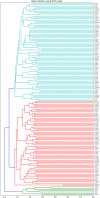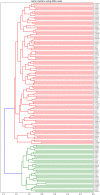Machine learning analysis of exome trios to contrast the genomic architecture of autism and schizophrenia
- PMID: 32111185
- PMCID: PMC7049199
- DOI: 10.1186/s12888-020-02503-5
Machine learning analysis of exome trios to contrast the genomic architecture of autism and schizophrenia
Abstract
Background: Machine learning (ML) algorithms and methods offer great tools to analyze large complex genomic datasets. Our goal was to compare the genomic architecture of schizophrenia (SCZ) and autism spectrum disorder (ASD) using ML.
Methods: In this paper, we used regularized gradient boosted machines to analyze whole-exome sequencing (WES) data from individuals SCZ and ASD in order to identify important distinguishing genetic features. We further demonstrated a method of gene clustering to highlight which subsets of genes identified by the ML algorithm are mutated concurrently in affected individuals and are central to each disease (i.e., ASD vs. SCZ "hub" genes).
Results: In summary, after correcting for population structure, we found that SCZ and ASD cases could be successfully separated based on genetic information, with 86-88% accuracy on the testing dataset. Through bioinformatic analysis, we explored if combinations of genes concurrently mutated in patients with the same condition ("hub" genes) belong to specific pathways. Several themes were found to be associated with ASD, including calcium ion transmembrane transport, immune system/inflammation, synapse organization, and retinoid metabolic process. Moreover, ion transmembrane transport, neurotransmitter transport, and microtubule/cytoskeleton processes were highlighted for SCZ.
Conclusions: Our manuscript introduces a novel comparative approach for studying the genetic architecture of genetically related diseases with complex inheritance and highlights genetic similarities and differences between ASD and SCZ.
Keywords: Autism spectrum disorder; Genomic; Machine learning; Schizophrenia; Unsupervised clustering.
Conflict of interest statement
The authors declare that they have no competing interests.
Figures
Similar articles
-
Synaptic and Gene Regulatory Mechanisms in Schizophrenia, Autism, and 22q11.2 Copy Number Variant-Mediated Risk for Neuropsychiatric Disorders.Biol Psychiatry. 2020 Jan 15;87(2):150-163. doi: 10.1016/j.biopsych.2019.06.029. Epub 2019 Jul 11. Biol Psychiatry. 2020. PMID: 31500805 Free PMC article.
-
Comparative yield of molecular diagnostic algorithms for autism spectrum disorder diagnosis in India: evidence supporting whole exome sequencing as first tier test.BMC Neurol. 2023 Aug 5;23(1):292. doi: 10.1186/s12883-023-03341-0. BMC Neurol. 2023. PMID: 37543562 Free PMC article.
-
Damaging coding variants within kainate receptor channel genes are enriched in individuals with schizophrenia, autism and intellectual disabilities.Sci Rep. 2019 Dec 16;9(1):19215. doi: 10.1038/s41598-019-55635-4. Sci Rep. 2019. PMID: 31844109 Free PMC article.
-
Molecular signatures from multi-omics of autism spectrum disorders and schizophrenia.J Neurochem. 2021 Nov;159(4):647-659. doi: 10.1111/jnc.15514. Epub 2021 Sep 29. J Neurochem. 2021. PMID: 34537986 Review.
-
Genetic architecture of autism spectrum disorder: Lessons from large-scale genomic studies.Neurosci Biobehav Rev. 2021 Sep;128:244-257. doi: 10.1016/j.neubiorev.2021.06.028. Epub 2021 Jun 21. Neurosci Biobehav Rev. 2021. PMID: 34166716 Review.
Cited by
-
Challenges and prospects in bridging precision medicine and artificial intelligence in genomic psychiatric treatment.World J Psychiatry. 2024 Aug 19;14(8):1148-1164. doi: 10.5498/wjp.v14.i8.1148. eCollection 2024 Aug 19. World J Psychiatry. 2024. PMID: 39165556 Free PMC article. Review.
-
Medication Usage Record-Based Predictive Modeling of Neurodevelopmental Abnormality in Infants under One Year: A Prospective Birth Cohort Study.Healthcare (Basel). 2024 Mar 24;12(7):713. doi: 10.3390/healthcare12070713. Healthcare (Basel). 2024. PMID: 38610136 Free PMC article.
-
Review: Cancer and neurodevelopmental disorders: multi-scale reasoning and computational guide.Front Cell Dev Biol. 2024 Jul 2;12:1376639. doi: 10.3389/fcell.2024.1376639. eCollection 2024. Front Cell Dev Biol. 2024. PMID: 39015651 Free PMC article. Review.
-
Exploring the Intersection of Schizophrenia, Machine Learning, and Genomics: Scoping Review.JMIR Bioinform Biotechnol. 2024 Nov 15;5:e62752. doi: 10.2196/62752. JMIR Bioinform Biotechnol. 2024. PMID: 39546776 Free PMC article.
-
A deep learning model for prediction of autism status using whole-exome sequencing data.PLoS Comput Biol. 2024 Nov 8;20(11):e1012468. doi: 10.1371/journal.pcbi.1012468. eCollection 2024 Nov. PLoS Comput Biol. 2024. PMID: 39514604 Free PMC article.
References
-
- Griswold AJ, Dueker ND, Van Booven D, Rantus JA, Jaworski JM, Slifer SH, et al. Targeted massively parallel sequencing of autism spectrum disorder-associated genes in a case control cohort reveals rare loss-of-function risk variants. Mol Autism. 2015;6:43. doi: 10.1186/s13229-015-0034-z. - DOI - PMC - PubMed
MeSH terms
LinkOut - more resources
Full Text Sources
Medical



